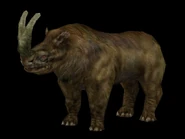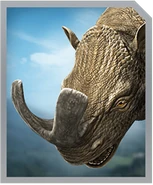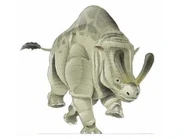Megacerops, previously known as Brontotherium and Brontops, is a large brontothere from Late Eocene North America. It is a member of the Brontotheriidae, a prehistoric odd-toed ungulate family. Although they looked rather like modern day rhinoceros, they were more closely related to horses.
Description[]
All of the species had a pair of blunt horns on their snout (the size varying between species), with the horns of males being much larger than those of the females. They are an extinct genus of the prehistoric odd-toed ungulate family Brontotheriidae, an extinct group of rhinoceros-like browsers related to horses. Brontotheriidae is a family mammals that lived in Paleogene (from lower Eocene until lower Oligocene) in North America, Asia and Europe. They stood about 2.5 metres tall at the shoulders and fed on relatively soft vegetation (leaves; probably, fruit). Brontotheriidae’s skulls were quite massive; however their brains were small.
Their heads with protruding eyes were "crowned” by horns shaped by swollen nose bones; on the outside, these horns were covered in skin. Wide and long horns of some species branched out at their base, while in other species they formed a Y-shaped protuberance.Probably, the habitat of Brontotheriidae was damp and warm, such as lakes surrounded by reeds and water bushes. Scientists consider climate change and consequent change in vegetation the main reason for the extinction of these rhinoceros-like ‘thunder horses”. Another possible reason for their brief existence was the small size of their brains and imperfect teeth.
Brontotherium is one of those prehistoric megafauna mammals that has been "discovered" over and over again by generations of paleontologists, as a result of which it has been known by no less than four different names (the others are the equally impressive Megacerops, Brontops and Titanops). Lately, paleontologists have largely settled on Megacerops ("giant horned face"), but Brontotherium ("thunder beast") has proven more enduring with the general public — perhaps because it evokes a creature that has experienced its own share of naming issues, Brontosaurus. The North American Brontotherium (or whatever you choose to call it) was very similar to its close contemporary, Embolotherium, albeit slightly bigger and sporting a different head display, which was larger in males than in females.
Befitting its similarity to the dinosaurs that preceded it by tens of millions of years (most notably the hadrosaurs, or duck-billed dinosaurs), Brontotherium had an unusually small brain for its size. Technically, it was a perissodactyl (odd-toed ungulate), which places it in the same general family as prehistoric horses and tapirs, and there's some speculation that it may have figured on the lunch menu of the huge carnivorous mammal Andrewsarchus.
One other odd-toed ungulate to which Brontotherium bears a marked resemblance is the modern rhinoceros, to which the "thunder beast" was only distantly ancestral. Just like rhinos, though, Brontotherium males battled each other for the right to mate — one fossil specimen bears direct evidence of a healed rib injury, which could only have been inflicted by the twin nasal horns of another Brontotherium male. Sadly, along with its fellow "brontotheres," Brontotherium went extinct around the middle of the Cenozoic Era, 35 million years ago —possibly because of climate change and the dwindling of its accustomed food sources.
References[]
- https://prehistoric-fauna.com/Megacerops
- https://www.thoughtco.com/brontotherium-megacerops-1093175
- https://www.fossilguy.com/gallery/vert/mammal/land/brontothere/index.htm
- https://www.jstor.org/stable/1306330
In the Media[]
- The Megacerops was a common enemy in the Sunstorm game Carnivores: Ice Age under its' junior synonym Brontotherium.
- Megacerops appeared in the documentary series called Paleoworld in the episode "Are Rhinos Dinos?".
- In the 2002 film Ice Age, two notable individual species named Carl (voiced by Michael Strahan) and Frank (voiced by Stephen Root) are brontotheres. However, it is only referred to as "rhinos" in the film. The brontotheres shown in Ice Age were two different species: Megacerops (under its' junior synonym Brontotherium) and Embolotherium, which had varying horns, one large, thin, double-pointed horn and one large, flat, double ended horn, respectively.
- Megacerops was added as a Solid Gold pack Cenozoic savannah on February 9th, 2018 in Jurassic World: The Game under its' junior synonym Brontotherium.
- Megacerops is a common Cenozoic creature in Jurassic World: Alive under its' junior synonym Brontotherium.
- Megacerops appears in Dino Dana under its' junior synonym Brontotherium.
- Megacerops appeared recently in the new Netflix Original Documentary Series, Life On Our Planet.








